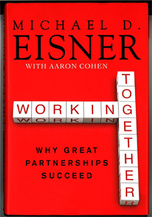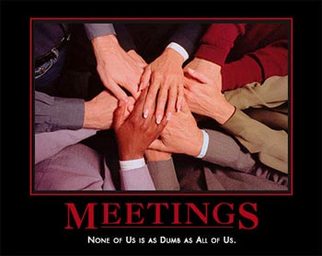 I recently completed Michael Eisner's new book on successful partnerships called Working Together. I was very motivated to read the book because I have had both good and bad teamwork/partnership experiences in the past, and I was curious to hear about how 11 of the world's most famous partnerships worked. I understand that all people and partnerships are different, and all of the lessons may not apply to everyone directly. However, I wanted to understand as closely as possible the things that made others' partnerships work and not work so that I too can be an effective partner and can identify potential effective partnerships to be a part of in the future. (I will confess that I "read" this work as an audiobook and was not able to take great notes on it. Most of the information below is from the best of my memory, and where it's sparse, it's all my fault; the actual text has a lot of great stories and details that left an impression on me but which I can't perfectly recall.)
I enjoyed the book greatly, both from the perspective of partnership and also from the perspective of entrepreneurship. It was fascinating to hear the stories of such a diversity of businesses being started up, and similarly, such a diversity of people working together. I realized the key in all of these partnerships were the following commonalities:
The combination of matching and non-matching elements, when present in an environment of trust and respect, can lead to some pretty remarkable results. Eisner concluded the book with some thoughts on why to even be in partnership and how to set them up. He said that in the end, what makes life truly worth living is sharing experiences with other people. This is the core reason at the end of the day to have partners. He says that if partnerships have failed for you in the past, the problem is not with partnership in general, and so you should keep trying new partnerships until you find some that work. I personally think that for some people or in some situations, full equal partnerships might not be the best. But no matter what the actual situation, treating your peers as partners with full respect, trust, and support always does. In addition, he cautions against using pre-nuptial agreements or buy-sell agreements in businesses (contracts that aim to plan for the partnership dissolving). He says they are unproductive and cause more hurt than good. He preaches that people should work things out, and if they can't, to part ways. I personally think this is a valiant notion, but often times the complexities and logistics with figuring out how to part ways once there is trouble can be much worse than planning for it when times are good. I really think it depends on the type of personalities of the partners; if they are both level-headed, rational, and can think about the issues at arm's length in the beginning when setting up a fair agreement, it will not do much harm and can prevent problems down the line.
0 Comments
In my last entrepreneurial finance class, we went over a reading by a famous Harvard professor of entrepreneurship, one of the first formal papers on the subject submitted to a colloquium in the 1980s. It is surprising how much the advice from 30 years ago is so close to today's. Below were the points that most caught my eye and caused me to think; some I agree wholeheartedly with, and others I'm still trying to come to terms with.
I found that most of the lessons above rang true today and particularly hit close to home for me and my personal past experiences. I'm sure I read advice like this before, but it's strange how it always takes on a new meaning when it matches things that you've actually had to deal with in your personal life. I feel a bit like Borat as I write the title of this post -- reminds me too much of "Cultural Learnings of America for Make Benefit Glorious Nation of Kazakhstan." Except in this case, it's not just cultural learnings, and it's not just Kazakhstan that's benefiting.
The "America" that I dived into this week is called business school orientation at UCLA Anderson. It's been a lot of fun, and I've really enjoyed meeting my classmates and taking part in all of the activities so far. The experiences have been pretty varied, including classwork and games/experiential activities. I'm looking forward to even more non-traditional learning experiences next week as we play even more games and do an obstacle course (yes, of course this is critical for becoming a true professional!). At the same time on my own, I've been reading Nassim Taleb's first book (before Black Swan) called Fooled by Randomness. I've been pleasantly surprised to have already learned something substantial and non-intuitive from my orientation experiences which ties in with my independent reading as well. My main "light bulb moment" learning experience was during the murder mystery. Yes, we had a murder mystery to solve on our second day of business school. It was presented like a normal business school "case" (written by Stanford Graduate School of Business), except instead of a business situation, it presented the facts and testimonies of different suspects of a murder mystery. Our task was to solve it, and we were allowed to work in teams. My team, like almost all the others, formed by just combining the people sitting around the same area (who were all assigned seats randomly anyways). We read the case, discussed it, and picked the wrong answer. Nice way to fail the first assignment, huh? Except that this failure probably taught me more than if we had succeeded. What we later learned is that not every person received the same case handout and mystery facts. In fact, different versions with extra information were spread out around the room, so getting input from people around the room would've helped solve the crime better. In addition, our team's conversation started with a vote of who each of us thought did it, then a discussion of the merits of each person's case, and then finally a team compromise or decision on who we would convict. We started with the goal of conviction, discussed the evidence that most of us had in common in our cases rather than diving deeply into analyzing some details of the evidence, and came out with little new information than when we started. This proved to be a pretty ineffective way to go in hindsight. I learned many things from this exercise. First, studies have shown that most teams end up forming by physical proximity, personal similarity, and other criteria of convenience. This ends up putting people together who already share a lot in common. This makes it easy to work together but lousy to create new ideas or have intense breakthroughs or changes in any one person's opinion. The best teams are often the most diverse, bringing people together from different backgrounds and ideally dissenting intellectual opinions so as to foster critical, deep analysis rather than simply agreeing or glossing over things that each person assumes all the others know or agree with. The second thing I learned was that in teams, the most discussed knowledge is common knowledge. People like talking about things they understand and know and compare new data to that. They tend to have a "confirmation bias" in incorporating new data that makes it a lot more difficult to take in a fact that refutes an established theory than one that simply supports what they already know. Unfortunately, this makes it a lot harder to actually be creative and sometimes leads to fatal mistakes, like the NASA Columbia disaster, blamed in part on this type of "groupthink." It turns out that teams that welcome dissenting and minority opinions and environments where even smaller or non-traditional viewpoints are thoroughly discussed and fleshed out produce better outcomes. Having someone play devil's advocate sincerely or actively considering multiple options before deciding on a plan of action will make it a lot less likely to ignore important details. For example, in the murder mystery, if someone had extra information about the stolen wallet and asked a question like, "What about the wallet?," many teams would respond by saying, "Yeah, so what?," thereby making it awkward to discuss something that is actually not common knowledge but which is made to seem like common knowledge. Instead of making assumptions or jumping to conclusions on what's redundant or already known, each team member's thoughts should be fully heard out and considered for what they could potentially change or refute in the team's current thinking. Also, we would statistically have been better off if we worked in an evidence-based manner (rather than verdict-based). Instead of first starting with a vote and seeing how close we were to our "mission" of reaching consensus, we could've ignored our own initial anchoring positions and simply delved into the evidence directly and discussed it as a group. This would prevent anyone from having to go back on what they proposed earlier or worry about saving face. This sort of advice goes well for juries that are deciding a final verdict based on evidence. This discussion of being evidence-based and looking for clues that refute existing theories reminded me a lot of my reading in Fooled by Randomness. I'm only halfway through the book, but the first half has been stressing the difference between pseudo-science/finance/economics/"theories" that can never be proven because they speak about something fundamentally untestable or about the future versus true science and theories that can easily be refuted/shown wrong. For example, "All swans are white" can be refuted by the existence of one black swan, but seeing thousands of white swans does not really help in "proving" the initial statement. If teams can come up with hypotheses together that can be tested against evidence and challenged/shown wrong, then the team can make decisions in a manner that's rational and eventually more effective. This was exactly the approach shown by the "correct answer" of the case: analyzing each character's evidence in turn and seeing what pieces of evidence could "acquit" a particular character's "guilty" verdict. The character who could not be acquitted by any evidence was the one chosen as the guilty party. I'm looking forward to many more fun and deeply educational experiences in the coming weeks. |
Archives
February 2023
Categories
All
Subscribe |


 RSS Feed
RSS Feed

